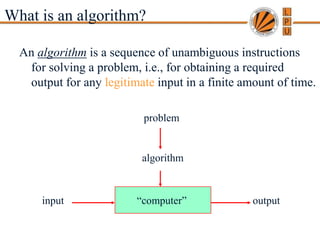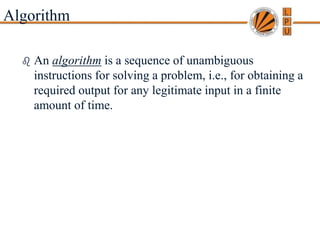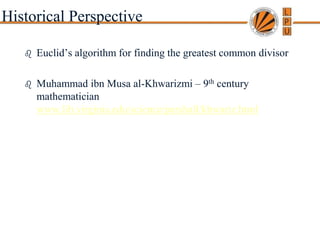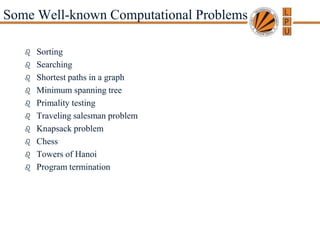lecture 1(Fundamental of algorithms).pptx
- 1. Copyright © 2007 Pearson Addison-Wesley. All rights reserved. A. Levitin “Introduction to the Design & Analysis of Algorithms,” 2nd ed., Ch. 1 CSE408 Fundamentals of Algorithms Lecture #1
- 2. Copyright © 2007 Pearson Addison-Wesley. All rights reserved. A. Levitin “Introduction to the Design & Analysis of Algorithms,” 2nd ed., Ch. 1 What is an algorithm? An algorithm is a sequence of unambiguous instructions for solving a problem, i.e., for obtaining a required output for any legitimate input in a finite amount of time. “computer” problem algorithm input output
- 3. Copyright © 2007 Pearson Addison-Wesley. All rights reserved. A. Levitin “Introduction to the Design & Analysis of Algorithms,” 2nd ed., Ch. 1 Algorithm An algorithm is a sequence of unambiguous instructions for solving a problem, i.e., for obtaining a required output for any legitimate input in a finite amount of time. • Can be represented various forms • Unambiguity/clearness • Effectiveness • Finiteness/termination • Correctness
- 4. Copyright © 2007 Pearson Addison-Wesley. All rights reserved. A. Levitin “Introduction to the Design & Analysis of Algorithms,” 2nd ed., Ch. 1 Historical Perspective Euclid’s algorithm for finding the greatest common divisor Muhammad ibn Musa al-Khwarizmi – 9th century mathematician www.lib.virginia.edu/science/parshall/khwariz.html
- 5. Copyright © 2007 Pearson Addison-Wesley. All rights reserved. A. Levitin “Introduction to the Design & Analysis of Algorithms,” 2nd ed., Ch. 1 Notion of algorithm and problem “computer” algorithmic solution (different from a conventional solution) problem algorithm input (or instance) output
- 6. Copyright © 2007 Pearson Addison-Wesley. All rights reserved. A. Levitin “Introduction to the Design & Analysis of Algorithms,” 2nd ed., Ch. 1 Example of computational problem: sorting Statement of problem: • Input: A sequence of n numbers <a1, a2, …, an> • Output: A reordering of the input sequence <a´ 1, a´ 2, …, a´ n> so that a´ i ≤ a´ j whenever i < j Instance: The sequence <5, 3, 2, 8, 3> Algorithms: • Selection sort • Insertion sort • Merge sort • (many others)
- 7. Copyright © 2007 Pearson Addison-Wesley. All rights reserved. A. Levitin “Introduction to the Design & Analysis of Algorithms,” 2nd ed., Ch. 1 Selection Sort Input: array a[1],…,a[n] Output: array a sorted in non-decreasing order Algorithm: for i=1 to n swap a[i] with smallest of a[i],…,a[n] • Is this unambiguous? Effective? • See also pseudocode, section 3.1
- 8. Copyright © 2007 Pearson Addison-Wesley. All rights reserved. A. Levitin “Introduction to the Design & Analysis of Algorithms,” 2nd ed., Ch. 1 Some Well-known Computational Problems Sorting Searching Shortest paths in a graph Minimum spanning tree Primality testing Traveling salesman problem Knapsack problem Chess Towers of Hanoi Program termination Some of these problems don’t have efficient algorithms, or algorithms at all!
- 9. Copyright © 2007 Pearson Addison-Wesley. All rights reserved. A. Levitin “Introduction to the Design & Analysis of Algorithms,” 2nd ed., Ch. 1 Basic Issues Related to Algorithms How to design algorithms How to express algorithms Proving correctness Efficiency (or complexity) analysis • Theoretical analysis • Empirical analysis Optimality
- 10. Copyright © 2007 Pearson Addison-Wesley. All rights reserved. A. Levitin “Introduction to the Design & Analysis of Algorithms,” 2nd ed., Ch. 1 Algorithm design strategies Brute force Divide and conquer Decrease and conquer Transform and conquer Greedy approach Dynamic programming Backtracking and branch-and-bound Space and time tradeoffs
- 11. Copyright © 2007 Pearson Addison-Wesley. All rights reserved. A. Levitin “Introduction to the Design & Analysis of Algorithms,” 2nd ed., Ch. 1 Analysis of Algorithms How good is the algorithm? • Correctness • Time efficiency • Space efficiency Does there exist a better algorithm? • Lower bounds • Optimality
- 12. Copyright © 2007 Pearson Addison-Wesley. All rights reserved. A. Levitin “Introduction to the Design & Analysis of Algorithms,” 2nd ed., Ch. 1 What is an algorithm? Recipe, process, method, technique, procedure, routine,… with the following requirements: 1. Finiteness terminates after a finite number of steps 2. Definiteness rigorously and unambiguously specified 3. Clearly specified input valid inputs are clearly specified 4. Clearly specified/expected output can be proved to produce the correct output given a valid input 5. Effectiveness steps are sufficiently simple and basic
- 13. Copyright © 2007 Pearson Addison-Wesley. All rights reserved. A. Levitin “Introduction to the Design & Analysis of Algorithms,” 2nd ed., Ch. 1 Why study algorithms? Theoretical importance • the core of computer science Practical importance • A practitioner’s toolkit of known algorithms • Framework for designing and analyzing algorithms for new problems Example: Google’s PageRank Technology
- 14. Copyright © 2007 Pearson Addison-Wesley. All rights reserved. A. Levitin “Introduction to the Design & Analysis of Algorithms,” 2nd ed., Ch. 1 Euclid’s Algorithm Problem: Find gcd(m,n), the greatest common divisor of two nonnegative, not both zero integers m and n Examples: gcd(60,24) = 12, gcd(60,0) = 60, gcd(0,0) = ? Euclid’s algorithm is based on repeated application of equality gcd(m,n) = gcd(n, m mod n) until the second number becomes 0, which makes the problem trivial. Example: gcd(60,24) = gcd(24,12) = gcd(12,0) = 12
- 15. Copyright © 2007 Pearson Addison-Wesley. All rights reserved. A. Levitin “Introduction to the Design & Analysis of Algorithms,” 2nd ed., Ch. 1 Two descriptions of Euclid’s algorithm Step 1 If n = 0, return m and stop; otherwise go to Step 2 Step 2 Divide m by n and assign the value of the remainder to r Step 3 Assign the value of n to m and the value of r to n. Go to Step 1. while n ≠ 0 do r ← m mod n m← n n ← r return m
- 16. Copyright © 2007 Pearson Addison-Wesley. All rights reserved. A. Levitin “Introduction to the Design & Analysis of Algorithms,” 2nd ed., Ch. 1 Fundamentals of Algorithmic Problem Solving
- 17. Copyright © 2007 Pearson Addison-Wesley. All rights reserved. A. Levitin “Introduction to the Design & Analysis of Algorithms,” 2nd ed., Ch. 1 Two main issues related to algorithms How to design algorithms How to analyze algorithm efficiency
- 18. Copyright © 2007 Pearson Addison-Wesley. All rights reserved. A. Levitin “Introduction to the Design & Analysis of Algorithms,” 2nd ed., Ch. 1 Algorithm design techniques/strategies Brute force Divide and conquer Decrease and conquer Transform and conquer Space and time tradeoffs Greedy approach Dynamic programming Iterative improvement Backtracking Branch and bound
- 19. Copyright © 2007 Pearson Addison-Wesley. All rights reserved. A. Levitin “Introduction to the Design & Analysis of Algorithms,” 2nd ed., Ch. 1 Analysis of algorithms How good is the algorithm? • time efficiency • space efficiency • correctness ignored in this course Does there exist a better algorithm? • lower bounds • optimality
- 20. Copyright © 2007 Pearson Addison-Wesley. All rights reserved. A. Levitin “Introduction to the Design & Analysis of Algorithms,” 2nd ed., Ch. 1 Important problem types sorting searching string processing graph problems combinatorial problems geometric problems numerical problems
- 21. Copyright © 2007 Pearson Addison-Wesley. All rights reserved. A. Levitin “Introduction to the Design & Analysis of Algorithms,” 2nd ed., Ch. 1 Sorting (I) Rearrange the items of a given list in ascending order. • Input: A sequence of n numbers <a1, a2, …, an> • Output: A reordering <a´ 1, a´ 2, …, a´ n> of the input sequence such that a´ 1≤ a´ 2 ≤ … ≤ a´ n. Why sorting? • Help searching • Algorithms often use sorting as a key subroutine. Sorting key • A specially chosen piece of information used to guide sorting. E.g., sort student records by names.
- 22. Copyright © 2007 Pearson Addison-Wesley. All rights reserved. A. Levitin “Introduction to the Design & Analysis of Algorithms,” 2nd ed., Ch. 1 Sorting (II) Examples of sorting algorithms • Selection sort • Bubble sort • Insertion sort • Merge sort • Heap sort … Evaluate sorting algorithm complexity: the number of key comparisons. Two properties • Stability: A sorting algorithm is called stable if it preserves the relative order of any two equal elements in its input. • In place : A sorting algorithm is in place if it does not require extra memory, except, possibly for a few memory units.
- 23. Copyright © 2007 Pearson Addison-Wesley. All rights reserved. A. Levitin “Introduction to the Design & Analysis of Algorithms,” 2nd ed., Ch. 1 Selection Sort Algorithm SelectionSort(A[0..n-1]) //The algorithm sorts a given array by selection sort //Input: An array A[0..n-1] of orderable elements //Output: Array A[0..n-1] sorted in ascending order for i 0 to n – 2 do min i for j i + 1 to n – 1 do if A[j] < A[min] min j swap A[i] and A[min]
- 24. Copyright © 2007 Pearson Addison-Wesley. All rights reserved. A. Levitin “Introduction to the Design & Analysis of Algorithms,” 2nd ed., Ch. 1 Searching Find a given value, called a search key, in a given set. Examples of searching algorithms • Sequential search • Binary search … Input: sorted array a_i < … < a_j and key x; m (i+j)/2; while i < j and x != a_m do if x < a_m then j m-1 else i m+1; if x = a_m then output a_m; Time: O(log n)
- 25. Copyright © 2007 Pearson Addison-Wesley. All rights reserved. A. Levitin “Introduction to the Design & Analysis of Algorithms,” 2nd ed., Ch. 1 String Processing A string is a sequence of characters from an alphabet. Text strings: letters, numbers, and special characters. String matching: searching for a given word/pattern in a text. Examples: (i) searching for a word or phrase on WWW or in a Word document (ii) searching for a short read in the reference genomic sequence
- 26. Copyright © 2007 Pearson Addison-Wesley. All rights reserved. A. Levitin “Introduction to the Design & Analysis of Algorithms,” 2nd ed., Ch. 1






![Copyright © 2007 Pearson Addison-Wesley. All rights reserved. A. Levitin “Introduction to the Design & Analysis of Algorithms,” 2nd ed., Ch. 1
Selection Sort
Input: array a[1],…,a[n]
Output: array a sorted in non-decreasing order
Algorithm:
for i=1 to n
swap a[i] with smallest of a[i],…,a[n]
• Is this unambiguous? Effective?
• See also pseudocode, section 3.1](https://image.slidesharecdn.com/lecture1fundamentalofalgorithms-230217162001-84b227be/85/lecture-1-Fundamental-of-algorithms-pptx-7-320.jpg)















![Copyright © 2007 Pearson Addison-Wesley. All rights reserved. A. Levitin “Introduction to the Design & Analysis of Algorithms,” 2nd ed., Ch. 1
Selection Sort
Algorithm SelectionSort(A[0..n-1])
//The algorithm sorts a given array by selection sort
//Input: An array A[0..n-1] of orderable elements
//Output: Array A[0..n-1] sorted in ascending order
for i 0 to n – 2 do
min i
for j i + 1 to n – 1 do
if A[j] < A[min]
min j
swap A[i] and A[min]](https://image.slidesharecdn.com/lecture1fundamentalofalgorithms-230217162001-84b227be/85/lecture-1-Fundamental-of-algorithms-pptx-23-320.jpg)


